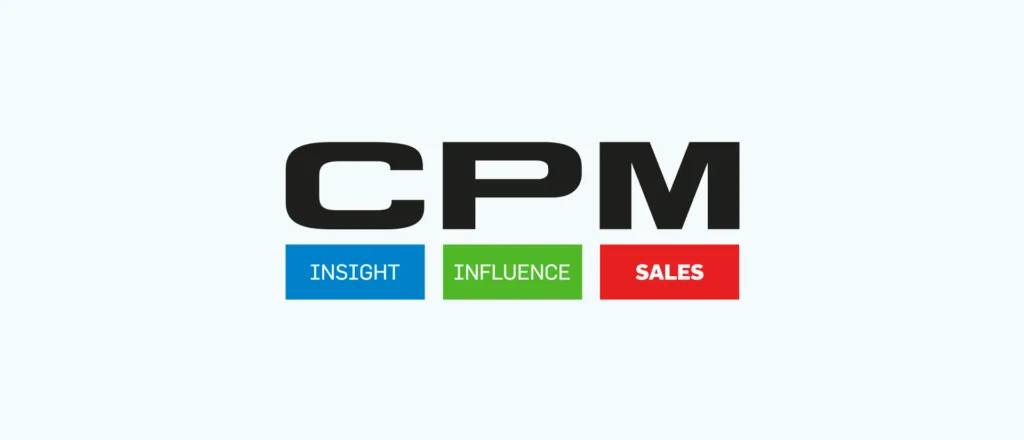Build the Best Marketing Plan – The Ultimate Guide to CPM

What Does CPM Mean?
CPM, or Cost Per Mille, is a core concept in advertising and marketing, meaning "cost per thousand impressions." The term originates from the Latin word "mille," which means "thousand."
In digital advertising, CPM is a pricing model. This model provides advertisers with broad reach, focusing on the number of times an ad is displayed rather than on click-through or conversion rates. It also offers publishers (such as website or app owners) a predictable source of revenue. Through CPM, publishers can charge advertisers a fixed fee for every 1,000 ad impressions, helping them measure and predict their earnings. This model is widely used in the programmatic advertising ecosystem, allowing advertisers to automatically purchase ad space to ensure their ads reach the desired target audience.
Overall, CPM is an important metric that helps advertisers and publishers evaluate and optimize their online advertising strategies. By understanding CPM, all parties can manage advertising budgets more effectively and improve the return on investment of their ad placements.
How Does CPM Work?
CPM is an online advertising billing model based on the number of ad impressions. It emphasizes broad exposure rather than clicks or conversions. CPM can help companies achieve extensive brand exposure at a relatively low cost, but it also requires considering the measurement and visibility standards of impressions.
The CPM model is common in media selection, traffic-related marketing, and online advertising. For example, platforms like Google Ads and Facebook marketing campaigns use CPM as part of their pricing structure or bidding options.
Impressions are a key metric for measuring how often an ad is displayed on a website. Each time an ad is shown when a page loads, even if the viewer only glances at it, it counts as an impression. Despite the briefness of the view, each impression has the potential to catch attention or leave a lasting impression, which is the effectiveness of the CPM model.
How to Calculate CPM?
To calculate CPM, a company can divide the total cost of the ad by the total number of impressions, and then multiply the result by 1,000.
For example, if an ad costs $10,000 and it receives 10,000 impressions, the CPM is $10. This metric helps companies measure the efficiency of their ads, understand the cost per 1,000 views, and represent how digital publishers charge for ad space.

- Total Ad Cost: The total amount paid by the advertiser for the campaign, including all related fees.
- Total Impressions: The total number of times the ad is displayed to users over a certain period.
- Calculating CPM: First, divide the total ad cost by the total impressions to get the average cost per impression. Then, to get CPM, multiply this average cost by 1,000, as CPM is based on the cost per thousand impressions.
What is an Appropriate CPM Range?
The appropriate CPM range depends on various factors, including ad type, target audience, advertising platform, market competition, industry standards, and the advertiser's budget and goals. There is no fixed standard as CPM rates vary with these factors. Different industries have different CPM standards. For example, some industries may have higher CPMs due to high competition and valuable audiences, while others may be lower.
On the Google Ads platform, advertisers typically see CPM rates ranging from a few dollars to several tens of dollars, depending on keyword competition, audience targeting, and ad type.
Facebook Ads CPM rates usually range from $2 to $10 for some target audiences, influenced by ad type, settings, and audience targeting.
TikTok ad CPM rates can range from a few yuan to several tens of yuan, varying with ad type (e.g., static images, dynamic images, video ads) and audience targeting.
Advantages and Disadvantages of Using CPM
CPM is suitable for brand exposure and broad reach but not ideal for advertisers needing precise conversion and ROI measurement. Advertisers should consider their advertising goals, budget, and market conditions when choosing CPM.
Advantages
1. Simple and Intuitive: CPM provides an easily understood metric, allowing advertisers to understand the cost per 1,000 ad impressions easily.
2. Brand Exposure: CPM is ideal for brand promotion and awareness as it focuses on the number of ad impressions rather than clicks or conversions.
3. Predictable Budgeting: Advertisers can allocate a fixed amount for ad impressions, aiding in financial planning and control.
4. Broad Reach: CPM ensures ads are widely displayed, helping advertisers reach a broader audience.
5. Suitable for Video and Display Ads: For ad formats focused on impressions, such as video and banner ads, CPM is an appropriate billing method.
6. Reduced Click Fraud: CPM is not dependent on clicks for billing, reducing the risk of click fraud.
Disadvantages
1. Unknown Conversion Rates: CPM does not guarantee any form of conversion or clicks, making the actual effectiveness of ads hard to measure.
2. Potential Cost Inefficiency: Low conversion rates, even with a low CPM, might lead to wasted ad budgets.
3. Limited Audience Targeting: CPM might not offer as granular audience targeting options as other models like CPC or CPA.
4. Visibility Issues: CPM focuses only on the number of impressions, not on the actual visibility or user engagement with the ad.
5. High Competition Markets: In competitive markets, CPM can become very high, increasing ad costs.
6. Difficult to Measure Effectiveness: Since CPM does not track clicks or conversions, measuring the direct effect and ROI (return on investment) of ads is challenging.
7. Potential Budget Overrun: Unexpectedly high ad impressions could lead to budget overruns.
How to Conduct a CPM Digital Marketing Campaign?
Conducting a CPM digital marketing campaign involves several steps, including planning, execution, and optimization.

Here are some key steps for conducting a CPM digital marketing campaign:
1. Set Goals and Budget:
- Define your marketing goals, such as brand awareness, product promotion, or increasing website traffic.
- Determine the amount you are willing to pay for every 1,000 ad impressions and set your budget accordingly.
2. Understand Your Audience:
- Research and define your target audience, including their interests, behaviors, and demographics.
3. Choose the Right Platforms:
- Select appropriate advertising platforms based on your target audience and marketing goals, such as Google Ads, Facebook Ads, TikTok, etc.
4. Create Engaging Ad Content:
- Design compelling ad creatives that align with your brand and marketing message.
- Create multiple versions of your ads to test which performs better.
5. Set Up Your Campaign:
- Set up your ad campaign on the chosen platforms, including audience targeting, geographic location, display times, etc.
- Set your CPM bids and adjust the ad budget as needed.
6. Launch Your Campaign:
- Launch the ad campaign and monitor its performance.
7. Optimize Your Campaign:
- Use the collected data to optimize ad content, audience targeting, bidding strategy, etc.
- Test different ad versions and targeting options to find the best combination.
8. Adjust Budget and Bids:
- Adjust your budget and CPM bids based on the campaign's performance and ROI.
- If an ad performs poorly, consider reducing its budget or stopping it altogether.
9. Report and Summarize:
- Regularly generate reports summarizing the campaign's performance and learnings.
- Analyze which strategies were effective and which need improvement, and adjust future marketing plans accordingly.
10. Continuous Learning and Adaptation**:
- Keep up with the latest trends and technologies in the constantly changing digital marketing environment.
- Adapt to market changes and continuously optimize your CPM strategy.
CPM vs. CPC vs. CPA
CPM, CPC, and CPA are three common billing models in digital marketing.
CPM (Cost Per Mille) is suitable for brand awareness and building brand recognition, easy to understand and calculate, and helps advertisers control the budget for ad impressions. However, it does not guarantee clicks or conversions and maybe cost-efficient if the conversion rate is low.
CPC (Cost Per Click) refers to the amount advertisers pay for each click on their ad. It directly measures ad interaction, emphasizing user interest and engagement, and is usually more cost-effective than CPM because it only charges for actual clicks. However, it may be subject to click fraud.
CPA (Cost Per Action) refers to the amount advertisers pay for each specific action (such as registration, purchase, etc.) completed by users. It is very effective for direct response advertising and performance marketing. It is usually more cost-effective than CPM and CPC because it only charges for successful conversions. However, it is less effective for brand awareness.
Applicable Scenarios
CPM: Suitable for marketing activities aimed at brand promotion, product launches, and increasing brand awareness.
CPC: Suitable for marketing activities that need to increase website traffic or user engagement.
CPA: Suitable for sales-driven marketing activities, especially e-commerce and direct response advertising.
Additionally, here's a list of average social media advertising costs on different platforms, just for reference:

F&Q
What is CPM on YouTube?
CPM on YouTube is a metric that measures the cost an advertiser pays for every 1,000 ad impressions on YouTube videos. If a creator has a high CPM, it means advertisers are paying more for the ad displays on that video, and consequently, the creator might earn more from those ad displays.
It’s important to note that YouTube's CPM does not directly equate to the creator's actual earnings because YouTube takes a percentage of the ad revenue.
YouTube also introduced RPM (Revenue Per Mille), a metric that reflects the total earnings of a creator after YouTube’s share, including ad revenue and income from other monetization channels. RPM takes into account the total views of a video, including those that did not generate revenue, providing creators with a more comprehensive understanding of their channel's earnings.
What does a $20 CPM mean?
A $20 CPM means that an advertiser pays $20 for every 1,000 views of their video ad. In other words, if an ad is viewed 1,000 times on YouTube, the advertiser needs to pay $20 to the platform or the content creator.
Difference Between CPM and eCPM?
CPM and eCPM are related but distinct concepts in the digital advertising realm:
1. CPM: Stands for Cost Per Mille, representing the cost an advertiser pays for every 1,000 ad impressions. It’s an ad-buying model where the advertiser pays based on the number of times the ad is displayed, regardless of whether these impressions result in clicks or conversions.
2. eCPM: Stands for Effective Cost Per Mille, a metric used to indicate the average revenue generated per 1,000 ad impressions. eCPM considers not only the number of impressions but also click-through rates, conversion rates, and other user engagement factors, providing a more comprehensive reflection of an ad’s performance and revenue effect.
Summary of Differences:
- CPM focuses on the cost from the advertiser's perspective.
- eCPM focuses on revenue from the publisher’s or media owner’s perspective.
- CPM is a fixed purchase cost, while eCPM is a dynamic revenue metric that can reflect the actual performance and audience engagement of an ad.
- eCPM can be used to compare the effectiveness of different ad purchasing models (such as CPC or CPA) by converting the revenue from various models into a uniform measure per 1,000 impressions.














